Keeping Windows 11 lean and bloat-free is increasingly important for performance and privacy, especially on low-end machines. MSMG Toolkit is a powerful tool that helps you remove unnecessary Windows components and create a custom lightweight ISO. This guide shows you how to use MSMG Toolkit to decrapify Windows 11 effectively.
Why Decrapify Windows 11?
Windows 11 comes with many pre-installed apps and services that eat up resources, such as Cortana, Xbox Game Bar, and telemetry tools. Removing these can result in a more responsive system with less background activity, fewer updates, and enhanced privacy.
Benefits:
- Improved system performance
- More disk space
- Less telemetry and tracking
- Ideal for low-end PCs and resource-constrained environments
- MSMG Toolkit: Download MSMG Toolkit and extract it.
- Windows 11 24H2 ISO: Download the latest Windows 11 ISO and move it to the
ISOfolder in the Toolkit. - Rufus: Download Rufus Tool to create a bootable USB after customizing the ISO.
Step-by-Step Guide to Decrapifying Windows 11 24H2
1. Setting Up MSMG Toolkit
- Open
Toolkit\Start.cmd. - Accept the terms by typing “a” and pressing Enter.
- Navigate to Source and select
Extract Source from DVD ISO Image. Point to your downloaded ISO file. - Select
Select Source from <DVD> Folder, accept the prompts, and choose your licensed Windows 11 edition.
2. Removing Windows Components
System Components to Remove:
This step removes features that are rarely used by most users:
- Device Lockdown
- File History
- Manual Setup
- System Restore
- Windows Backup
- Windows Subsystem for Linux (WSL)
- WordpadMultimedia Components:
Multimedia components take up space and resources. Remove these if they’re unnecessary:
- Windows Media Player
- First Logon Animation
- Speech Recognition
- Windows System Assessment ToolPrivacy Components:
Ensure better privacy by removing telemetry features:
- All Privacy Components (including Windows Error Reporting and CEIP)System Apps:
MSMG Toolkit allows you to remove numerous system apps that bloat the OS. For instance:
- Assigned Access Lock App
- Edge Classic Browser
- Content Delivery Manager
- Quick Assist
- Windows Mixed Reality
- Windows Defender AppWindows Apps:
Get rid of pre-installed apps such as:
- Cortana
- Xbox Game Bar
- Microsoft News
- Sticky Notes
- Your Phone3. Customizing the OS
In the Customize section, apply important tweaks to disable unwanted features:
- Disable Automatic Driver Updates via Windows Update
- Disable Windows Defender and SmartScreen
- Disable Cortana App and Microsoft Reserved Storage for updates
- Enable Windows Classic Context Menus
- Disable Windows 11 Installer Hardware Check for easier installation on older systems
Use the Apply Tweaks option to make these changes.
4. Finalizing the ISO
Once you’ve customized your Windows setup, it’s time to apply the changes:
- Go back to the main menu and select Apply Source. This saves your modifications.
- Clean up the source images with Cleanup Source Images.
- Under Target, choose
Make a DVD ISO Image. This creates a new ISO file with your changes.
5. Creating a Bootable USB
Use Rufus to create a bootable USB from your customized ISO:
- Download and open Rufus.
- Select your customized Windows ISO from the MSMG Toolkit
ISOfolder. - Create your bootable USB to install your decrapified Windows 11.
Additional Tips for a Lightweight Windows 11:
- Remove Windows Copilot: Available in 24H2, this new AI assistant can be removed to save resources.
- Awesome muso & WinTool: After installation,
- hit Windows + X
- choose
Terminal (Admin)orPowerShell (Admin) - paste
irm gg.gg/awesomemusoand press Enter - follow instructions to further tweak and setup your Windows
Conclusion
By following these steps, you can create a streamlined version of Windows 11 that is faster, more efficient, and more private. MSMG Toolkit is a powerful tool that gives you control over what stays and what goes in your Windows installation. Whether you’re running on low-end hardware or just prefer a leaner setup, this guide ensures you’re maximizing performance while keeping unwanted bloatware at bay.
Feel free to share your results or feedback on your decrapified Windows 11 setup!
MSMG Toolkit
This is an UnOfficial backup repository for MSMG Toolkit.
➡️ MSMG Toolkit is a tool that helps users customize and optimize Microsoft Windows installations. It is a useful tool for those who want to create a custom Windows installation disk that fits their specific needs. This tool is particularly useful for creating custom, bloat-free Windows installations.
👉 Precautions
- MSMG Toolkit is not supported by Microsoft and is a third-party tool, so use at your own risk.
- MSMG Toolkit can alter Windows significantly, so understand the risks before use, especially if unfamiliar with Windows OS and components.
- Use MSMG Toolkit only on a clean Windows installation. Modifying a customized system may cause unexpected results.
- Experienced users should use MSMG Toolkit with caution, knowing the risks. Backup your system before making significant changes to your Windows installation.
👉 System Requirements
-
Windows 7 with SP1 / Windows 8.1 / Windows 10 / Windows 11 / Server 2008 R2 / Server 2012 R2 / Server 2016 / Server 2019 / Server 2022 LTSC Installation Disc DVD/ISO.
-
Windows 7 with SP1 / Windows 8.1 / Windows 10 / Windows 11 Host Operating System for Servicing Windows 7 / Windows 8.1 source images.
-
Windows 8.1 / Windows 10 / Windows 11 Host Operating System for Servicing Windows 7 / 8.1 / 10 / 11 source images.
-
The ToolkitHelper.exe requires Microsoft .NET Framework 4.8 or 4.9 runtime pack.
👉 Installation
⬇️ Download the latest version: Toolkit_v13.7.7z
⬇️ Official Download Page : msmgtoolkit/download
⬇️ Toolkit Archive:
download.ru/archives
⬇️ Toolkit Packs:
download.ru/packs
👉 Features
-
Localization Packs Integration
- Integrate Windows/WinPE Language Packs, Language Features Packs and Localize your Windows Installation.
-
Drivers Integration
-
Integrate device drivers into the Windows Installation image and Windows Installation Boot image (Boot.wim).
-
Import and integrate Host PC drivers into the Windows Installation image.
-
-
Feature Packs Integration
- Integrate Windows Feature Packs, Feature on Demand (FOD’s) Packs, Inbox Apps, Add-on Packs.
-
Updates Integration
- Integrate Windows updates and service packs.
-
Component Removal
- Reduce Windows footprint by removing unwanted components of your choice and simplify your installation time and free up drive space.
-
Customization
- Customize Windows look and feel with custom cursors, themes and skin packs.
-
Deploy Windows Image
- Deploy Windows installation image either in .WIM/.ESD format through USB/DVD media.
👈 List of things this Toolkit can do
- Copy Source DVD Files from DVD Drive
- Extract Source DVD Files from ISO Image
- Extract Source DVD Files from OEM/IMG Image
- Convert Windows Store ESD Image to WIM Image
- Convert Windows Media Creation Tool (MCT) Image to WIM Image
- Convert Windows ESD Image to WIM Image
- Convert Windows WIM Image to ESD Image
- Convert Source WIM Editions
- Integrate Windows Updates
- Integrate WHD Updates Repository Updates
- Integrate Windows Language Packs
- Integrate Windows Device Drivers
- Integrate Microsoft. NET Framework 3.5
- Integrate Microsoft. NET Framework 4.6.2 with Language Packs
- Integrate Microsoft Internet Explorer 11 with Language Packs
- Integrate Microsoft Data Deduplication
- Integrate Microsoft Edge Browser App
- Integrate Microsoft Remote Desktop Protocol 8.0 & 8.1
- Integrate Microsoft Win32 Calculator
- Integrate Windows Management Framework 5.1
- Integrate Windows Multimedia Restricted Codecs
- Integrate Windows Subsystem for Linux (WSL)
- Integrate Windows System Restore
- Integrate Windows To Go Workspace
- Integrate Microsoft Default Metro Apps
- Integrate Microsoft DaRT Tools to Boot & Recovery Images
- Integrate Windows Thin PC Add-on Packages
- Integrate Microsoft DirectX 9.0c
- Integrate Microsoft Games
- Integrate Windows Sidebar
- Integrate Windows 8.1 Media Center Generic Activation Tokens
- Integrate Windows 8.1 Pre-Activation Data & Tokens
- Integrate Terminal Server Patch
- Integrate Fraunhofer IIS MPEG Layer-3 Professional Codec Tweak
- Integrate Custom Themes UxTheme Patch
- Integrate Custom Windows Recovery Environment (WinRE)
- Integrate Custom Default User Account Pictures
- Integrate Custom System Files
- Remove All Default Metro Apps
- Remove Default Metro Apps Association
- Remove Windows Components
- Remove Windows Components using Package List.
- Import Default Metro Apps Association from XML File
- Export Default Metro Apps Association to an XML File
- Make a DVD ISO Image
- Burn an ISO Image to DVD
- Copy Source to Bootable USB Flash Drive
- Sync Source Boot and Install Images to Bootable USB Flash Drive
- Burn an ISO Image to Bootable USB Flash Drive
- Format a USB Flash Drive
- WIM Manager to Display, Delete, Rename, Export, Split and Merge, Capture, Apply, and Cleanup WIM Image Indexes
- Load/Unload WIM Image Registry for Modification
👉 Usage
-
Fist Download the Toolkit .
-
Unblock the downloaded Toolkit archive file by righting clicking on the archive file and choose
propertiesand then click onUnblockbutton. -
Extract the Toolkit archive to a folder with shorter folder path (e.g:
C:\Toolkit) -
Extract/Copy the Windows Source ISO/DVD Image/Disc contents to Toolkit’s
<DVD>folder. -
Double Click on
Start.cmdand Choose Yes toRun as Administrator. -
Click on Toolkit’s Command Window Control Box and Choose Properties.
-
If using
Windows 7/Windows 8.1HOST OS then Go To Font Tab and Set the Font toConsolasand Font Size to16. -
Go to Layout Tab and Increase the Height to 1000 in Screen Buffer Size Group Box.
-
Agree to Toolkit’s
EULAby pressing ‘A’ Key
. -
Press
EnterKey to Continue. -
Integrate all the features you want to add except the
.NET Framework 3.5using the Integrate Feature Menu. -
Integrate the
Language packyou want if required. -
Integrate the
Updates. -
Remove the
Appsyou don’t want. -
Remove the
Componentsyou don’t want. -
Apply Changes; this will perform the
Cleanup -
Re-Mount the Source
-
Add the
.NET Framework 3.5using the Integrate Feature Menu
. -
Apply Changes.
-
Re-Build the Image.
👈 Known Issues
-
The Toolkit won’t work with long folder path or folder pathname containing spaces or special characters.
-
Using Toolkit with Antivirus Programs enabled can affect the Toolkit’s operations.
-
Toolkit’s component removal engine (ToolkitHelper.exe) may be flagged as a Virus/Trojan/Malware Program, don’t worry it’s just a false positive sign.
-
The Toolkit won’t support source images pre-serviced with other similar tools.
-
The Toolkit won’t support source images with mixed architectures.
-
Windows 8.1 — Default Metro Apps Pack missing Office OneNote appx file.
-
Windows 8.1 — Integrating Windows Remote Server Administration Tool (RSAT) along with other features will break the integration with an error code 0x80092004.
-
Windows 7,8.1,10 v1507/v1511/v1607/v1703/v1709/v1803 Component removal has been removed temporarily.
-
Windows 10 v1809 — Integrating or Installing Windows Updates after the component removal can restore removed components empty resource files/folders.
-
Windows 10 v1903/v1909/v2004/v20H2/v21H1/v21H2/v22H2, Windows 11 v21H2/v22H2 — Performing Image Clean-up causes Ghost SFC error, Running SFC /SCANNOW command will fix the issue.
-
Windows 10 v1903/v1909/v2004/v20H2/v21H1/v21H2/v22H2, Windows 11 v21H2/v22H2 — Integrating or installing Windows updates after the component removal will restore the removed components and this is due to the recent change in Microsoft update mechanism.
-
Windows 10 v1809/v1909/v2004/v20H2/v21H1/v21H2/v22H2, Windows 11 v21H2/v22H2 — Component Removal requires a source image with supported cumulative update integrated.
-
Windows 10 v1809/v1909/v2004/v20H2/v21H1/v21H2/v22H2, Windows 11 v21H2/v22H2 — Component Removal do not support ARM64 source images.
-
Windows 10 v1809/v1909 — Removing Cortana breaks Start Menu, Taskbar and Settings App Search functionality.
-
Windows 10 v1809/v1909/v2004/v20H2/v21H1/v21H2/v22H2, Windows 11 v21H2/v22H2 — Removing Internet Explorer breaks DirectX 9.0c web installer and Photoshop CC web installer.
-
Windows 10 v1809/v1909/v2004/v20H2/v21H1/v21H2/v22H2, Windows 11 v21H2/v22H2 — Removing Map Control component breaks Photos App image information.
-
Windows 10 v1703/v1709/v1803/v1809/v1903/v1909/v2004/v20H2/v21H1/v21H2/v22H2, Windows 11 v21H2/v22H2 — Custom User Account Picture integration is not working in Logon Screen although it’s been displayed in Start Menu user icon.
-
Windows 10 v1809/v1909/v2004/v20H2/v21H1/v21H2/v22H2, Windows 11 v21H2/v22H2 — Removing Cloud Experience Host requires fully unattended setup with SkipMachineOOBE setting enabled.
👉 Similar or Related Tools
- NTLite
- Tiny11Builder
- WinUtil
- Windows10Debloater
👉 Copyright
I hereby declare that I am not affiliated with the toolkit or its creator in any manner. Furthermore, I explicitly state that I bear no responsibility for the usage of this toolkit. The copyright for the toolkit remains the sole property of its original owner.
Windows 11 has been with us for some time now, and for those of us with the best desktops we can guarantee the best performance. But what about that five year old laptop that your aunt has? The one with 4GB of RAM and a CPU that fell out of the best CPUs category in the prior decade. Sure Linux is an option, but what if they really need that one Windows app?
This scenario is common to many of us who work in tech. A family member needs tech support and we don’t have a lot of time to help them. So what if there were a way to create a custom Windows 11 install, one that install on older hardware and breathe new life into it?
In this how to you’ll learn how to create your own custom Windows 11 image, ready for installation on your aunt’s old laptop, or on your gaming rig. An alternative to creating your own bespoke Windows 11 install is to use Tiny11 Builder. We sacrifice the ability to truly customize our install for a fully automated approach. If you are short on time, then perhaps this is a good compromise. But, if you want to truly tailor your Windows 11 experience, read on and learn exactly how.
Downloading the Windows 11 Image
Downloading the latest version of Windows 11 from Microsoft is generally the way to go, but for this custom build, the absolute latest bleeding edge release will be needed. The source of the latest bleeding edge release is uupdump, and from there is where this how to begins. The source ISO is the latest public version of Windows 11, which will be put through two tools, MSMG Toolkit and NTLite, to produce a custom ISO for machines which don’t make Windows 11’s cut.
1. Open a browser and go to uupdump.net and select the latest public release build for x64.
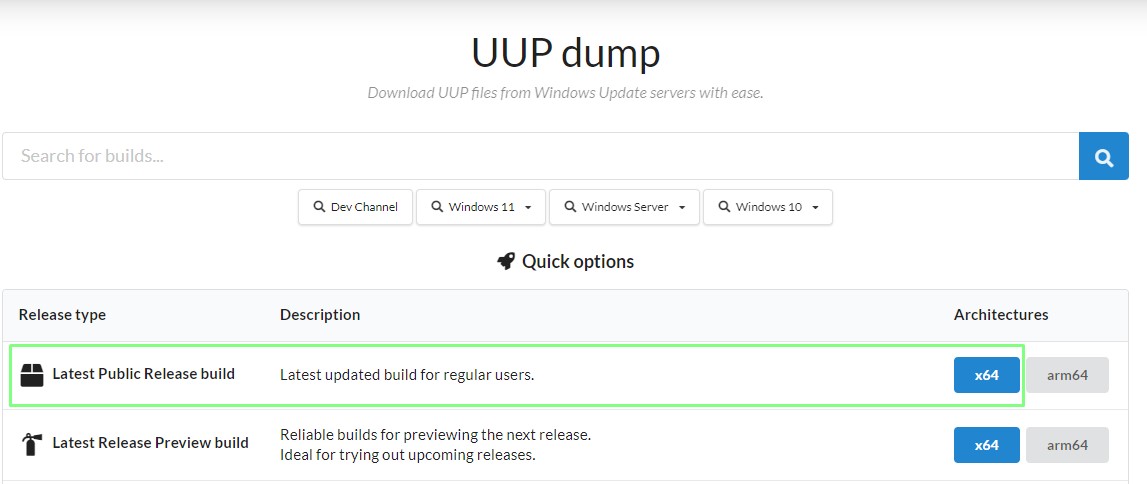
2. Select the latest Windows 11 version available.

3. Select your preferred language and click Next.
Get Tom’s Hardware’s best news and in-depth reviews, straight to your inbox.

4. Select Windows 11 Pro and click Next.
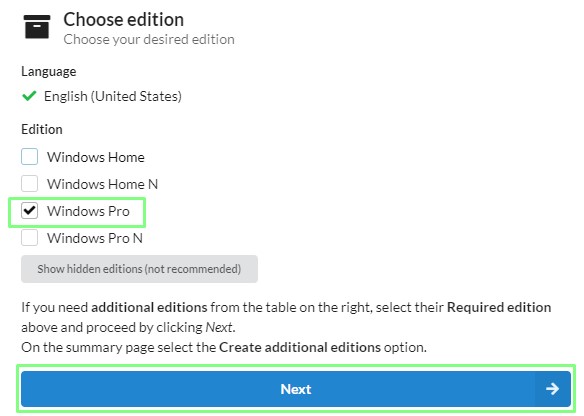
5. Select Run Component Cleanup and click on Create download package to start the download. This will download an archive containing a tool to download the ISO.
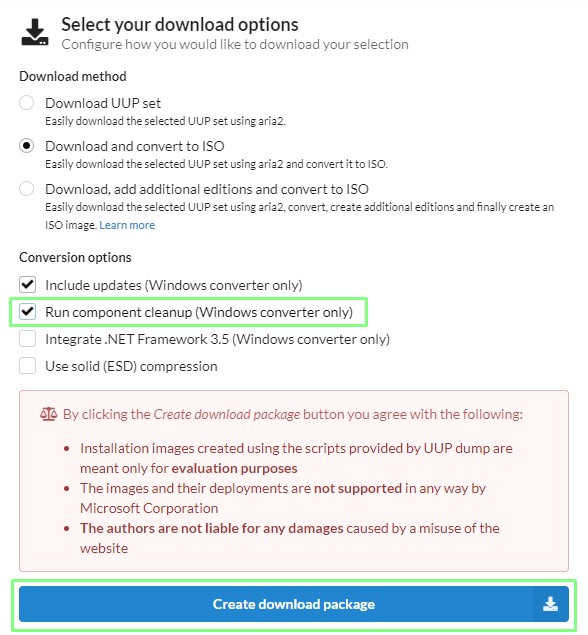
6. Extract the contents of the archive to a new folder on your desktop.
7. Open the folder and double click on the uup_download_windows file to start the download. When done, press 0 to exit the script.
MSMG Toolkit is a tool to tweak a Windows ISO to your own specifications. If you need to add specific drivers, updates or in this case, remove components and applications, then MSMG Toolkit is the tool to use. MSMG uses a DOS / ncurses type user interface via a command prompt, but don’t let that put you off. This is an easy tool to use.
In this part of the process we’ll use MSMG Toolkit to remove specific built-in applications and features of Windows 11. If you don’t need Microsoft Edge, Azure, OneDrive etc, then this is the tool to remove them. By doing this, the ISO image size is reduced, and ultimately the Windows 11 install size is reduced, and the number of processes is lowered, giving even a low power machine a chance of comfortably running Windows 11.
1. Download Toolkit v13.2.7z and extract the archive to your desktop. You may need to install nanazip to extract the archive. Nanazip can be found in the Microsoft Store.
2. Double click to mount the downloaded ISO image and extract the contents into the DVD folder inside Toolkit’s folder.

3. From the Toolkit_v13.2 folder, click on Start to run a command. You may need to authorize the application to start as it triggers a warning message.
4. Press A to accept MSMG Toolkit’s EULA. Then press any key to continue.
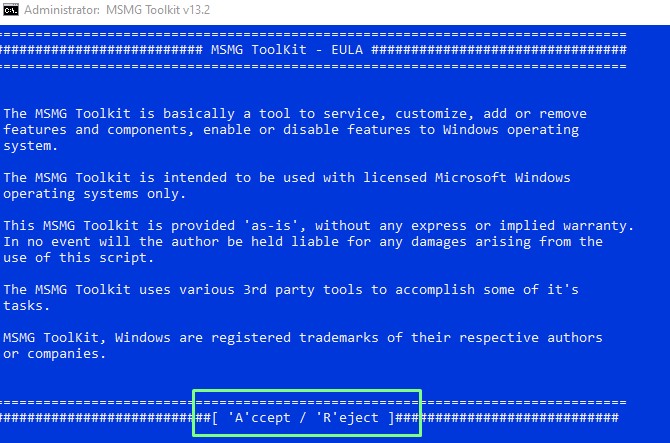
5. Select [1] Source.
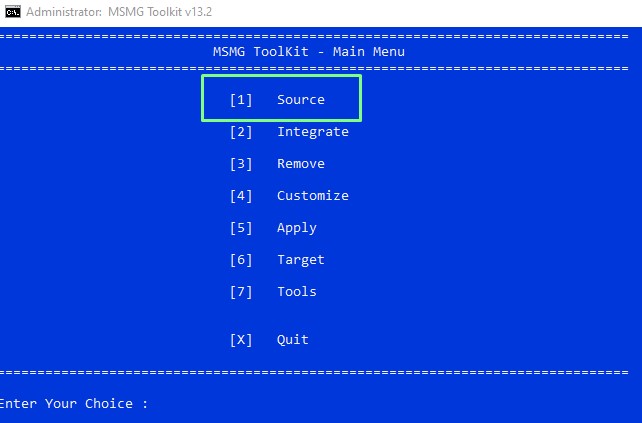
6. Press 1 to select the DVD folder as the source. Remember this is where the contents of the ISO have been copied.
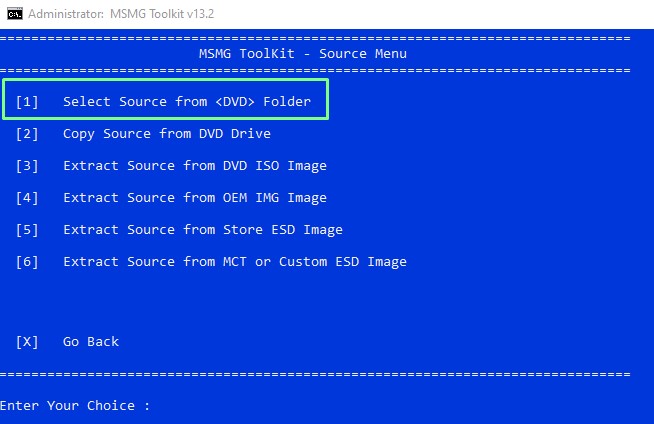
7. Press 1 and Enter to select Windows 11 Pro.
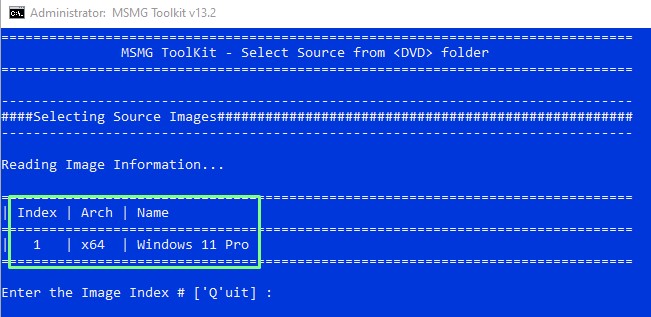
8. Select No to the questions “Do you want to mount Windows Setup Boot Image” and “Do you want to mount Windows Recovery Image?”
9. Press any key to continue.
10. Select [3] Remove and then, in the next menu, select [1] Remove Windows Components. In the final menu, press [1] to Select Windows Components. The different components / applications of Windows 11 are broken down into categories such as Internet, Multimedia etc. By entering the category we can add or remove components from the Windows 11 ISO. Steps 11 to 18 are optional, depending on what components you want to remove or keep.
11. Select [1] Internet and then select [3] to remove Internet Explorer. Press X to go back to the category menu. Options 1 and 2 can also be used to remove Microsoft Edge, but this will mean that you have no method to install an alternative browser unless you have one on a USB drive. Note that when an item is marked for removal, — will appear next to its entry.
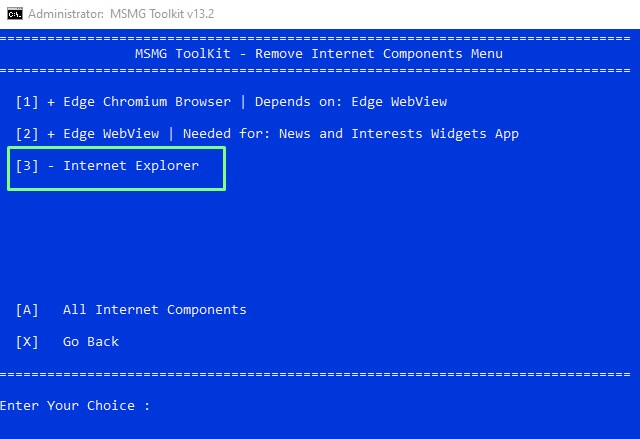
12. Select [2] Multimedia and press [1] to remove all of the components. Then press x to go back. Should you wish to be selective, press the corresponding letter to remove the entry. The multimedia components are some of the easiest to remove. Most of us don’t use a screen saver, wallpaper is easily found online and Windows Media Player is royally beaten by VLC.
[A] + First Logon Animation
[B] + Game Explorer | Needed for: Microsoft Games
[C] + Lock Screen Background
[D] + Screen Savers
[F] + Sound Themes
[G] + Speech Recognition | Needed for: Cortana, Ease of Access & OOBE
[H] + Wallpapers
[I] + Windows Media Player
[J] + Windows Photo Viewer
[K] + Windows Themes
[L] + Windows TIFF IFilter (OCR)
[M] + Windows System Assessment Tool13. Select [3] Network and select the following components 8, 9 to remove Microsoft Pay services and the Windows Mail application. Press X to go back. Networking tools such as SSH, TFTP and Telnet form the backbone of many developers’ workflows, but if you are just interested in gaming or surfing, then you’ll most likely not need them. Also, if you are planning to install a third-party SSH app such as Putty, you don’t need Windows built-in SSH client.
[1] + Offline Files
[2] + Open SSH
[3] + Remote Desktop Client
[4] + Remote Differential Compression (RDC)
[5] + Simple TCP/IP Services
[6] + Telnet Client
[7] + TFTP Client
[8] - Wallet Service | Needed for: Microsoft Pay
[9] - Windows Mail | Needed for: Windows Mail App14. Select [4] Privacy and remove the following components B, F, K,to remove the Customer Experience Improvement Program files, Picture Password and Windows Insider Hub. Press X to go back. The Customer Experience Improvement Program (CEIP) service is a voluntary scheme which collects data on how users work with Windows. This and the Picture Password, where you draw a pattern over a family photo, are really not necessary for the vast majority of users.
[A] + Assigned Access
[B] + Customer Experience Improvement Program (CEIP)
[C] + Face Recognition
[D] + Kernel Debugging | Depends on: Windows Error Reporting
[E] + Location Service
[F] + Picture Password
[G] + Pin SignIn Support
[H] + Unified Telemetry Client (Asimov) | Depends on: Windows Error Reporting
[I] + WiFi Network Manager (WiFi Sense)
[J] + Windows Error Reporting
[K] + Windows Insider Hub15. Select [5] Remoting and remove 3, OneDrive Desktop Client. If you want to use OneDrive, do not perform this step. Press X to go back. Here, MSMG can be used to remove the remote assistance and remote desktop tools. These can reduce the chances of external hacks, unless the hacker asks you to install their own software.
[2] + MultiPoint Connector
[3] - OneDrive Desktop Client
[4] + Remote Assistance
[5] + Remote Desktop Server
[6] + Remote Registry
[7] + Work Folders Client16. Select [6] System and remove the following components. C,E,F,G,N,P,Q,R,S. Press X to go back. Here is where the underlying software can be removed. If you need accessibility tools (On Screen Keyboard, Magnifier, Narrator etc) then leave option E as installed. The other suggestions, with the exception of System Restore and Backup can be removed. Think carefully about System Restore and Backup. They could prove useful should you need to rollback a driver issue.
[A] + Accessibility Tools
[C] + Device Lockdown (Embedded Experience)
[D] + Ease of Access Cursors | Depends on: Accessibility Tools
[E] + Ease of Access Themes | Depends on: Accessibility Tools
[F] + Easy Transfer
[G] + File History
[H] + Magnifier | Depends on: Accessibility Tools
[I] + Manual Setup (InPlace Upgrade)
[J] + Narrator | Depends on: Accessibility Tools
[K] + Notepad : | Needed for: Open With Dialog
[L] + On Screen Keyboard | Depends on: Accessibility Tools
[N] + Projected File System (ProjFS)
[O] + Security Center | Depends on: Windows Defender
[P] + Steps Recorder
[Q] + Storage Spaces
[R] + System Restore | Depends on: Windows Backup
[S] + Windows Backup
[T] + Windows Firewall
[U] + Windows Subsystem For Linux
[V] + Windows To Go
[W] + Wordpad17. Select [7] System Apps and remove the following components. 3,4,6,8,10,14,15,17,18,19,20,25,26,27,31,33,35,41,44,45,46 Press Enter after each number. Press X then Enter to go back. System apps are the Microsoft-centric apps that we either love or hate. The only app that we are on the fence about removing is File Explorer, because we use that app everyday. The rest, such as Async Text service, CBSPreview (a camera based barcode scanner) are all ripe for the chop.
[01] + AAD Broker Plugin - Credential Handler for Microsoft Azure Logon | Needed for: Microsoft Account, Windows Store
[02] + Accounts Control - App to add Microsoft Account for Microsoft Apps | Needed for: Windows Store
[03] + Add Suggested Folders to Library Dialog
[04] + App Resolver UX - Modern Open With Dialog
[05] + Assigned Access Lock App - Windows Kiosk Mode | Depends on: Assigned Access
[06] + Async Text Service - Messaging extensions for People and Maps Apps
[07] + Bio Enrollment - Windows Hello Setup
[08] + Calling Shell App - App to host call progress on shell
[09] + Capture Picker - A system picker UI control to select an item on the screen to capture | Needed for: Screen snip
[10] + CBSPreview - App for Camera Barcode Scanner
[11] + Content Delivery Manager - Automatic installation of sponsored or promoted apps, suggestions and Ads | Needed for: OOBE & Microsoft Account
[13] + Credential Dialog Host - Authentication (Sign-in) shell support for Windows Hello
[14] + ECApp - Modern UI Dialog App for Eye Movement Control | Depends on: WindowsMixedReality
[15] + Edge Classic Browser
[16] + Edge Developer Tools Client - An extension to edge containing tools for web developers | Depends on: Edge
[17] + File Explorer - Modern File Explorer App
[18] + File Picker - Modern File Picker Dialog
[19] + Lock App - Container App for Apps and Messages on the Lockscreen
[20] + Map Control
[21] + Narrator Quick Start - QuickStart Guide for Narrator
[22] + NcsiUwpApp - Network Connectivity Status Indicator (NCSI)
[23] + OOBE Network Captive Portal - Captive Network Portals support during OOBE-Phase of Windows
[24] + OOBE Network Connection Flow - Connection Flow Network Portals support during OOBE-Phase of Windows
[25] + Parental Controls - App for Parental Controls
[26] + People Experience Host - People Bar (People Hub)
[27] + Pinning Confirmation Dialog
[29] + Print Dialog - Modern Print Dialog | Needed for: Printing
[31] + Retail Demo Content
[33] + Secure Assessment Browser - Special Windows Mode for Exams (Take Test App) | Depends on: WebView2SDK
[34] + Setting Sync - Sync settings between your Windows PCs and devices
[35] + Skype ORTC
[36] + Smart Screen - Windows Defender SmartScreen Functionality for Modern Apps
[37] + Webcam Experience
[38] + WebView2 Runtime
[39] + Win32 WebView Host - Desktop App Web Viewer
[40] + Windows Defender App
[41] + Windows Mixed Reality
[42] + Windows Reader (PDF) | Depends on: Edge
[43] + Windows Store Back-end Client
[44] + Xbox Console Companion Back-end Client
[45] + Xbox Game Callable UI - Xbox Live
[46] + XGpu Eject Dialog - Modern Dialog App for safe removal of external GPUs18. Select [8] Windows Apps and remove the following components 1,5,7,8,9,11,16,17,18,22,24,25,32,33,34,35 Press Enter after each number. Press X then Enter to go back. These are the classic apps, many of which are never used. Widgets such as News, Office, Phone Link and Family are more of an annoyance than a convenience, so let’s lighten the load and slice these out of the ISO.
[01] + Alarms & Clock
[02] + App Installer
[03] + Calculator App
[04] + Camera
[05] + Clipchamp Video Editor
[06] - Cortana | Depends on: Speech Recognition
[07] + Family
[08] + Feedback Hub
[09] + Films & TV
[10] - Gaming App (Xbox App) | Depends on: Xbox Console Companion Back-end Client
[11] + Get Help
[12] + Google's VP9 WebM Video Codec Plugin
[13] + High Efficiency Image File (HEIF) Codec Plugin
[14] + High Efficiency Video Codec (HEVC) Plugin
[15] - Maps | Depends on: Map Control
[16] + Media Player
[17] + My Office
[18] + News
[19] + Notepad App
[20] + Paint
[21] - People | Depends on: People Bar
[22] + Phone Link
[23] + Photos
[24] + Power Automate Desktop
[25] + Quick Assist
[26] + Raw Image Extension
[27] + Screen Sketch
[28] - Solitaire Collection | Depends on: Xbox Live
[29] + Sticky Notes
[30] + Store Experience Host | Depends on: Windows Store App
[31] + Terminal
[32] + Tips - Windows tips and tutorials App
[33] + Todos
[34] + Voice Recorder
[35] + Weather
[36] + Web Media Codec Plugin
[37] + WebP Image Codec Plugin
[38] + Windows Web Experience Pack - News and Interests Widgets App | Depends on: Edge WebView
[39] - Windows Mail App | Depends on: Windows Mail
[40] + Windows Store App | Depends on: Windows Store Back-end Client, Xbox Identity Provider
[41] - Xbox Game Bar Plugin | Depends on: Xbox Console Companion Back-end Client
[42] - Xbox Game Bar |Depends on: Xbox Console Companion Back-end Client
[43] - Xbox Identity Provider | Depends on: Xbox Console Companion Back-end Client
[44] - Xbox Game Speech Window | Depends on: Xbox Console Companion Back-end Client
[45] - Xbox UI | Depends on: Xbox Console Companion Back-end Client
19. Press X to go back, then press [2] Start Removing Windows Components. This triggers the automatic removal of all the components that we have selected. The process can take some time. When done, press any key to exit.
20. Press X twice to go back to the first menu.
21. Select [5] Apply, then select [1] Cleanup Source Images.
22. Select [2] Apply & Save Changes to Source Images and when prompted to cleanup the image folder press Y.
23. Press X to quit, then any key to close the toolkit.
In the DVD folder there is now the filesystem that will make up the structure of the custom ISO image. But before it can be used as an ISO, more tweaking is required in NTLite.
Using NTLite to Tweak The Installation Image
NTLite is a useful tool, but many of us will never have heard of it. NTLite was developed to reduce the footprint of a Windows install, but it can also be used to remove Windows components and free up previous hard drive space. With NTlite you can create bespoke Windows ISOs to streamline your installation. NTLite is particularly useful in industries with harmonized platforms (the same spec machines for all staff).
In this part of the process, NTLite will be used to tweak the custom ISO to remove even more components and to tweak the ISO to bypass any RAM or TPM requirements.
1. Download and install NTLite
2. Open NTLite and select Add >> Image Directory. Choose the DVD directory from earlier and click Select Folder.
3. Double click on the entry to mount the image.

4. Select Components and then System.
5. Disable the following components by clicking to deselect their entries in the list.
57-Bit Linear Addressing
Application Virtualization
User Experience Virtualization
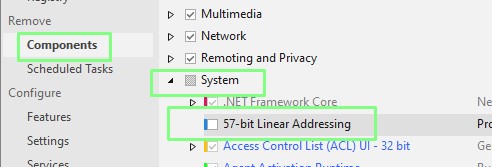
6. Select Components >> Remoting and Privacy.
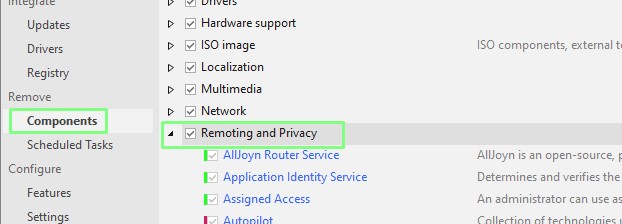
7. Disable the following components by clicking to deselect their entries in the list.
Braincache Client
File Server Resource Manager
Multipoint Connector
Peer Networking
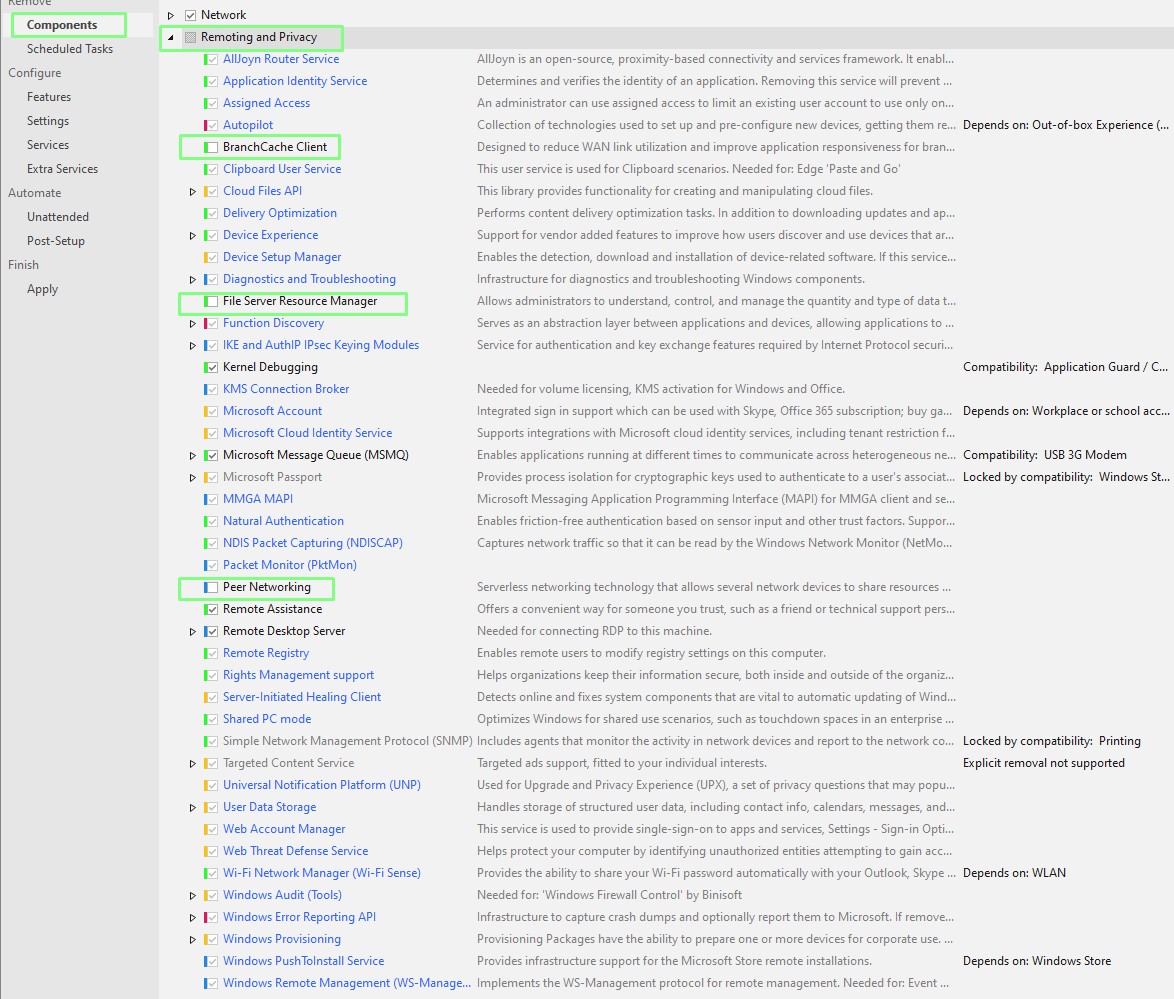
8. Select Multimedia and disable the Share Media Control Panel component.
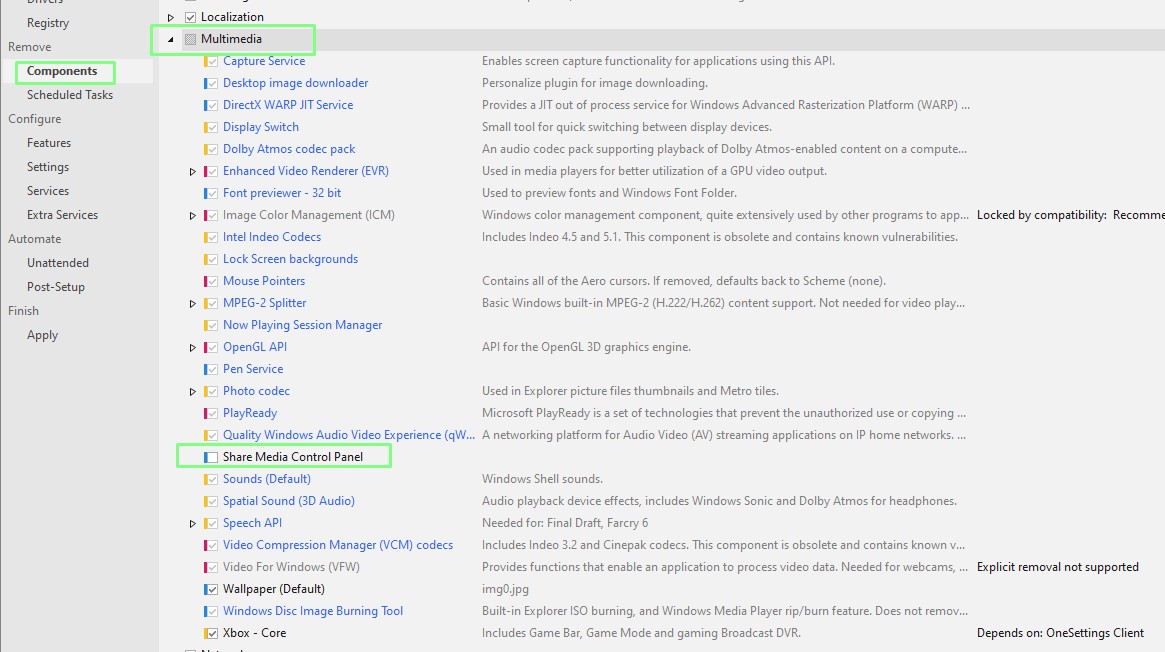
9. Click on Settings >> System and disable the following components by clicking to deselect their entries in the list.
Local User Account Setup Support
Setup Requirement — RAM
Setup Requirement — TPM and SecureBoot
Setup Requirement — TPM and SecureBoot — Host
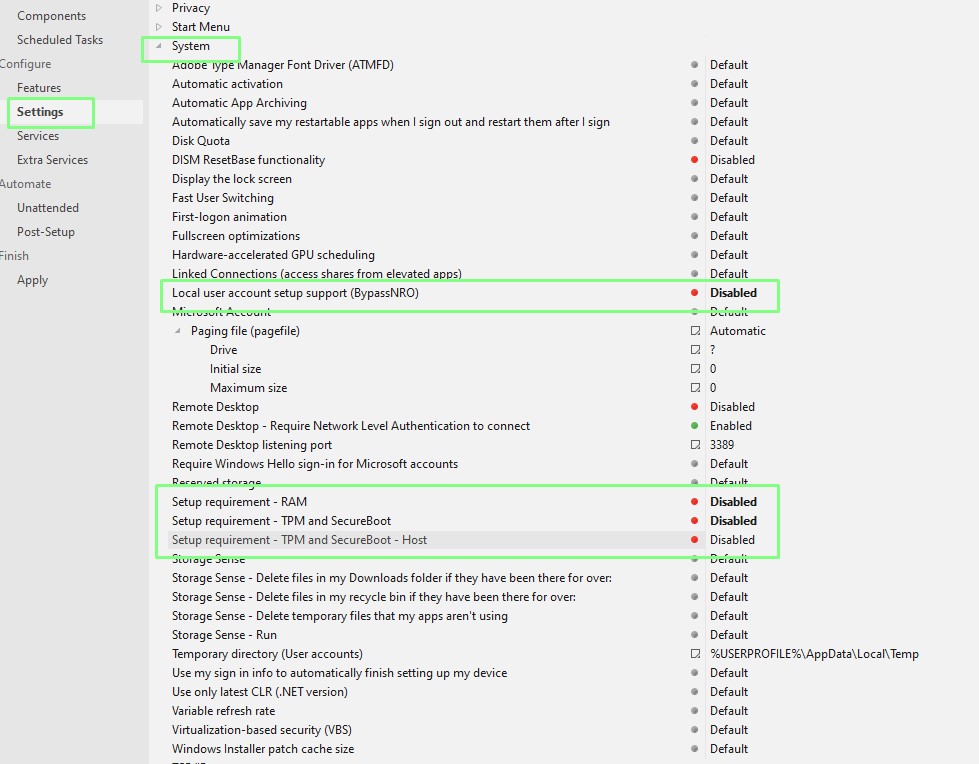
10. Using the search box, search for Teams and set it to disabled.

11. Search for Telemetry and set Allow Telemetry to Security | Disable.

12. Click on Unattended and set Compress Windows (Compact OS) to True.

13. Click on Apply.
14. Select Remove nonessential editions and click Process. This will trigger a prompt to disable Windows Defender. NTLite claims that disabling Windows Defender will speed up the process. In our tests we did not disable Defender and our Ryzen 5600X based system performed the task in a couple of minutes. Click OK when the process is complete.
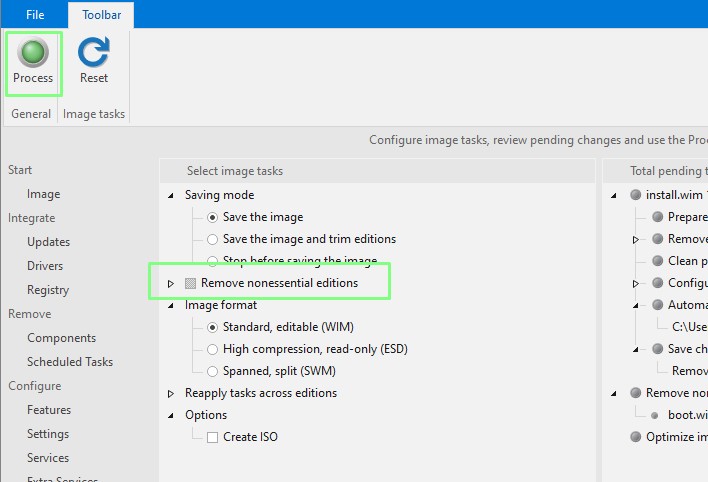
15. Click on Image and then select Boot/Setup.

16. Double click to mount the Microsoft Windows Setup image.

17. Click on Settings >> System and disable the following components.
Setup Requirement — RAM
Setup Requirement — TPM and SecureBoot
Setup Requirement — TPM and Secureboot — Host
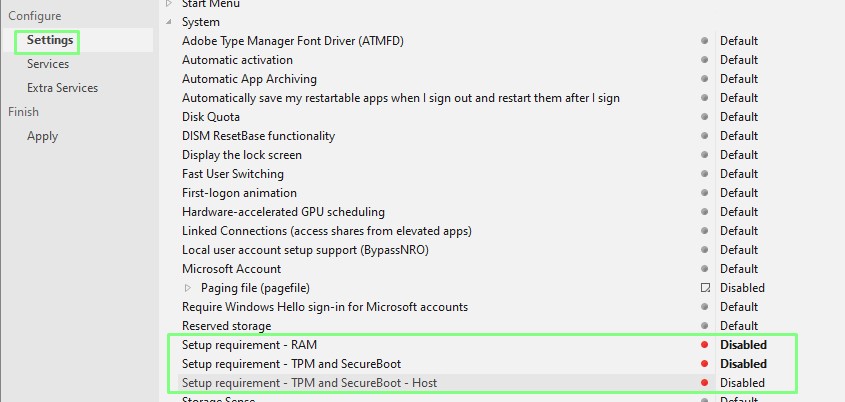
18. Click on Apply and then Process to write the changes. Click OK when done.
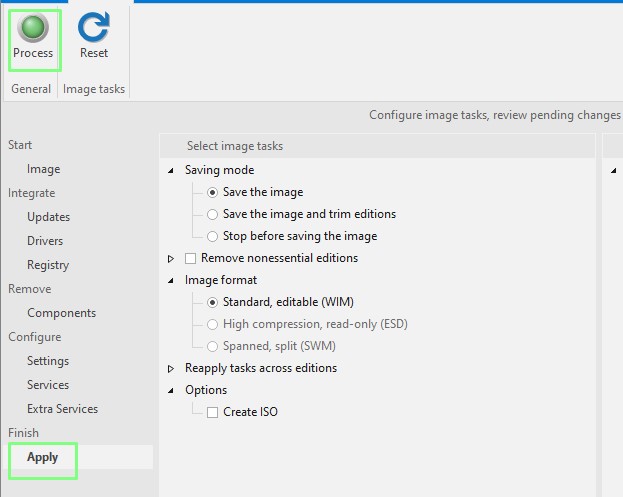
19. Click on the Windows 11 Pro image and then click on Create ISO. Save the ISO using a unique filename.
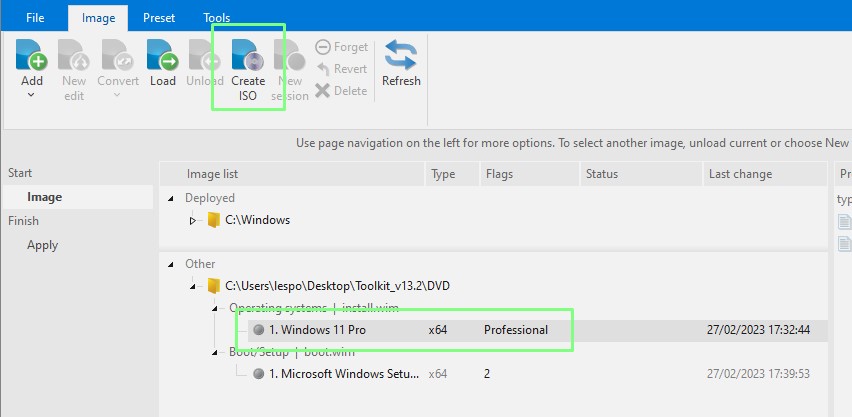
20. Write the ISO to a USB stick using Rufus, or test it via a virtual machine.
Once you are happy with the ISO, you can do a clean install of Windows 11 on the PC of your choice.
MORE: Make a Windows 11 Image That Runs on 2GB of RAM With Tiny11 Builder
Les Pounder is an associate editor at Tom’s Hardware. He is a creative technologist and for seven years has created projects to educate and inspire minds both young and old. He has worked with the Raspberry Pi Foundation to write and deliver their teacher training program «Picademy».
The MSMG ToolKit is getting an update having a collection of changes. You know this utility has ability to integrate updates or drivers without using functions and apps in Windows ISO. MSMG ToolKit 11.8 is bringing a Special structure of language packs folder for Windows 11.
This toolkit version carries some improvements not only for Windows 11 but also for Server 2022 and Windows 10. Deskmodder blog has discussed this update on its website.
MSMG ToolKit 11.8 improvements and changes
Here is the changelog –
- Updated the Toolkit Packs structure to support Windows 11 Source OS.
- Moved the WinPE Language Pack Patch files from Toolkit’s <Bin \ Patches> folder to <Packs \ LanguagePacks \ SourceOS \ ImageVersion \ Architecture> folder.
- MSMG ToolKit 11.8 updated the Feature Integrate Windows Language Packs to support Windows Server LTSC 2022 (v10.0.20348) Source OS.
- Updated the Feature Integrate Windows Language Packs to support Windows 11 v21H2 Insider Preview (v10.0.22000) Source OS.
- Added the Microsoft Windows Language Packs (Windows Server LTSC 2022 (v10.0.20348)) for MSMG Toolkit.
- Added the Microsoft Windows Language Packs (Windows 11 v21H2 Insider Preview (v10.0.22000)) for MSMG Toolkit.
- Updated the Feature Integrate Microsoft Default Inbox Apps to support Windows 11 v21H2 Insider Preview (v10.0.22000) Source OS.
- Updated the Feature Integrate Microsoft Default Inbox Apps to support integrating AV1 Video Extension Codec Plugin for Windows 10 32 bit Source OS.
- Added the Microsoft Default Inbox Apps Pack (Windows 11 v21H2) for MSMG Toolkit.
- MSMG ToolKit 11.8 updated the Microsoft Win32 Calculator Pack (Windows 10/Windows 11) for MSMG Toolkit with Windows 10 Enterprise LTSB 2016 (v10.0.14393) Win32Calc binary files.
- Updated the Microsoft .NET Framework 4.8 Pack (Windows 7 / Server 2008 R2) for MSMG Toolkit with .NET 4.8 KB5004755 (4.8.4410.1) (Thanks to MDL Member: abbodi1406).
- Updated the Microsoft Windows PowerShell 7 Pack (Windows 11 / Windows 10 / Windows 8.1 / Windows 7) for MSMG Toolkit with PowerShell 7.1.4 Runtime.
- MSMG ToolKit 11.8 updated the Microsoft Visual C++ Runtime Pack (Windows 11 / Windows 10 / Windows 8.1 / Windows 7) for MSMG Toolkit with VC++ 2022 v14.30.30528.0 Runtime (Thanks to MDL Member: abbodi1406).
- Updated the Feature Integrate WHD Update Pack to support Windows 11 v21H2 Insider Preview (v10.0.22000) Source OS (Thanks to MDL Member: th1r5bvn23).
- MSMG ToolKit 11.8 fixed a Bug in the Feature Remove Windows Component, where removing the component Windows Media Player would break the Apple iCloud Installer.
- Updated the Feature Remove Windows Component – XboxSpeechToTextOverlay, Split Windows XboxGameOverlay, XboxGamingOverlay, XboxTCUI, XboxIdentityProvider components from Xbox App component.
- Updated the Feature “Remove Windows Component” to support Windows 10 Client v1809 (v10.0.17763.2183) Source OS.
- Updated the Feature ‘Remove Windows Component’ to support Windows 10 Client v1903 / v1909 (v10.0.18362.1801 / v10.0.18363.1801) Source OS.
- MSMG ToolKit 11.8 updated the Feature “Remove Windows Component” to support Windows 10 Client v2004 / v20H2 / v21H1 / v21H2 (v10.0.19041.1237 / v10.0.19042.1237 / v10.0.19043.1237 / v10.0.19044.1237) Source OS.
- Updated the Feature “Remove Windows Component” to support Windows 11 Client v21H2 (v10.0.22000.1 / v10.0.22000.194) Source OS.
- Added DISM Remove Apps List Template for Windows 11 v21H2 Insider Preview (v10.0.22000) Source OS inside Toolkit’s <Bin \ Lists \ DISM_Templates> folder.
- Added DISM Remove Packages List Template for Windows 11 v21H2 Insider Preview (v10.0.22000) Source OS inside Toolkit’s <Bin\ Lists \ DISM_Templates> folder.
- MSMG ToolKit 11.8 added ToolKitHelper Remove Packages List Template for Windows 11 v21H2 Insider Preview (v10.0.22000) Source OS inside Toolkit’s <Bin \ Lists \ ToolkitHelper_Templates> folder.
- Added Features List Templates for Windows 11 v21H2 Insider Preview (v10.0.22000) Source OS inside Toolkit’s <Bin \ Lists \ Features_Templates> folder.
- Updated the Feature Apply Tweaks with Tweak to Disable Windows 11 Installer CPU Hardware Check for Windows 11 Source OS.
- Updated the Feature WIM Manager->Convert to support Windows 11 v21H2 Insider Preview (v10.0.22000) Source OS.
- Optimized the Toolkit code.
.
Windows 11 has been around for a while, and it has left many older systems unsupported. Despite the system requirements, installing Windows 11 on older hardware is not optimal, as the performance of the operating system is below par. This can be attributed to the installation disc or ISO image of the operating system provided by Microsoft.

The ISO image contains all of the components that will be installed on your computer. Most of these features are not used by users, so they serve no purpose at all. On the contrary, some of us tend to disable a number of features after performing a fresh install of the Windows operating system.
One possible way to circumvent these problems is to create a custom ISO image for yourself. There are numerous custom third-party ISO images available that have been stripped down to offer better performance on low-end computers. However, these third-party ISO images are not always recommended due to potential security risks and more.
In such a scenario, what you can do is create a custom ISO image of your own, where you can choose to remove the features that you do not use from the image and keep the ones that are important to you. This will result in a stripped-down installation of the Windows operating system, and ideally, it will even perform better.
1. Download the Windows 11 image.
To get started, the first thing you need to do is download the latest version of the Windows 11 ISO image on your computer. This can be found easily on the UUP Dump website. In this article, we will disclose two different tools that allow you to create custom images of the Windows operating system.
To download the latest Windows 11 image, follow the instructions below:
- First of all, head to the official UUP Dump website by clicking here.
- On the UUP Dump website, click on the x64 option for the Latest Public Release build.
Navigating to the Latest Public Releases - After that, click on the latest Windows 11 version. Make sure not to click on the update options here.
Downloading Windows 11 - On the next page, select your Language and click Next.
Choosing Windows Language - Then, select only Windows Pro from the Edition checkbox options and click Next.
Choosing Windows 11 Pro Edition - On the Summary page, check the “Run component cleanup” (Windows converter only) checkbox and click the “Create download package” option.
Downloading Windows 11 ISO Image - This will download a .zip file to your computer. Extract the file to any desired location on your PC.
- Navigate to the extracted directory and run the uup_download_windows.cmd file.
- A command prompt window will open which will start downloading the required files for you.
- Once the process is completed, you can press 0 on your keyboard to exit the script.
2. Use MSMG Toolkit.
MSMG Toolkit is a famous tool for tweaking Windows ISO images. The utility allows you to make any changes to the ISO image according to your requirements and specifications. This includes adding specific drivers to the ISO image, incorporating potential updates, or even removing components from the ISO image, which is the focus of this article.
An arguable downside of the MSMG Toolkit is that it uses a command-line interface; therefore, there is no graphical user interface that allows you to make these changes. If you would like to use a graphical user interface, refer to the following method below.
In this section, we will be showing you how to remove components from the Windows ISO image with the help of the MSMG Toolkit. Removing components from the ISO image also reduces the overall size of the ISO image, which as a result, reduces the installation size of Windows. Additionally, the number of processes running on your computer is also reduced, which can give you a performance boost.
Follow the instructions below to use the MSMG Toolkit for tweaking the Windows ISO:
- First, navigate to the official download page for the MSMG Toolkit by clicking here.
- From there, download the latest version of the MSMG Toolkit on your computer.
- Extract the downloaded file to any desired location.
- After that, double-click on the downloaded Windows ISO image on your PC. This will mount the ISO image.
- Then, copy the contents of the ISO image.
Copying Windows ISO Files - Navigate to the MSMG Toolkit folder and paste the contents into the DVD folder.
Navigating to the DVD Folder - Finally, go back and run the Start.cmd script. In the User Account Control dialog box, click Yes.
Running Start Script - On the EULA screen, press A on your keyboard to accept.
Accepting MSMG Toolkit EULA - After that, press 1 on your keyboard to navigate to Sources.
Navigating to Source Menu - Press 1 again to choose the Select Source from <DVD> Folder.
Selecting Source from DVD - Finally, press 1 once more to select the downloaded ISO image, Windows 11 Pro.
Selecting Windows 11 Pro - On the follow-up questions, select No. Then, press any key to continue to the main menu.
- After that, press 3 to navigate to the Remove menu.
Navigating to Remove Menu - Here, all of the different components are divided into their respective category.
- Navigate the Remove menu and select the respective options to remove any component from the ISO image.
- For instance, if you wish to remove Internet Explorer, select 1 to open the Internet category.
- After that, press 3 to select Internet Explorer for removal from the ISO image.
Removing Internet Explorer - Once you have selected all of the components you wish to remove, choose the [2] Start Removing Windows Components by pressing 2 on your keyboard in the Remove menu.
- The removal process can take a while so make sure to give it time.
- Then, go back to the main menu and press 5 to choose Apply.
Navigating to Apply Menu - After that, select the Cleanup Source Images option by pressing 1 on your keyboard.
- Finally, select the “Apply & Save Changes to Source Images” option by pressing 2. When prompted to clean up the image folder, press “Y” on your keyboard.
- At this point, everything is ready and you can create the final ISO image. To do this, choose the Target option on the main menu by pressing 6.
Navigating to Target Menu - On the Target menu, choose the Make a DVD ISO Image option by pressing 1.
- When asked for ISO Image Details, provide E: as the ISO Volume Label and follow it up by providing a name.
- Wait for the ISO image to be created. Once it is done, you will be able to view it inside the ISO folder of the directory.
3. Use NTLite.
NTLite is another utility that you can use to tweak Windows ISO images. It was essentially developed to reduce the footprint of Windows installation, but it comes with a number of features that you can use, including removing components from an ISO image.
NTLite even allows you to remove Windows 11 TPM and RAM requirements, along with providing a graphical user interface for all of this. Follow the instructions below to use NTLite on your computer:
- First, navigate to the official NTLite website and download the latest version available by clicking here.
- Run the setup file to install NTLite on your computer.
- After that, right-click on the downloaded Windows ISO image and extract it to any folder on your computer. You need to have WinRAR or 7-zip installed to do this.
- Open NTLite on your system.
- Click the Add option in the top-left corner and choose the Image directory option.
Adding Image to NTLite - Then, choose the folder where you extracted the Windows ISO image.
- After that, expand the added folder and right-click on Windows 11 Pro. Select “Load” from the drop-down menu.
Loading Windows 11 Image - Once you have loaded the ISO image, you can go through the various categories and remove the components you do not want in your custom ISO image.
- To remove a component, simply uncheck the checkbox next to the component or feature.
- After you are done, click Apply on the left-hand side.
Applying Changes to ISO - Finally, click the Create ISO option in the top-left corner to create a custom ISO image and save it in your desired location.
Creating ISO Image
Muhammad Zubyan
Muhammad Zubyan is a certified Google IT Support Professional with over 7 years of extensive experience. He has worked on more than 1500 computers, gaining valuable insights that enable him to detect and troubleshoot any complicated root cause of Windows-related issues and errors. In addition to managing Appuals as a Senior Editor, he is currently developing his own Game Optimization program that caters to both gamers and casual users alike.




















